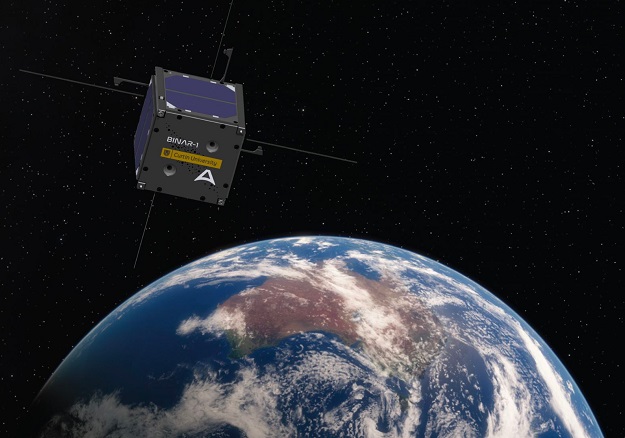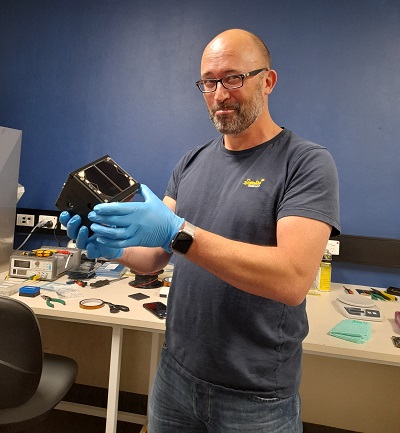
Artist’s impression of the Binar-1 satellite in orbit. Courtesy Curtin University.
Binar-1, Western Australia’s first home-grown spacecraft is due for launch from Cape Canaveral aboard a SpaceX rocket on 28 August.
The CubeSat, designed and built by staff and students from Curtin University’s Space Science and Technology Centre (SSTC), will be transported to the International Space Station (ISS) before being released into orbit.
The Binar Space Program is led by the SSTC in partnership with Fugro and supported by the Australian Remote Operations for Space and Earth (AROSE).
“Curtin’s incredible work on the Binar satellites through our Space Science Technology Centre has put us in the driver’s seat to deliver real outcomes for the WA and Australian space industries,” said Curtin University Vice-Chancellor, Professor Harlene Hayne.
“It will also further advance Curtin’s goal of enriching WA’s economy and workforce, by linking the Binar Program with local industries and connecting them with a real pathway to the burgeoning space sector.”
SSTC Director and John Curtin Distinguished Professor, Phil Bland, said the launch of Binar-1 was just the beginning.
“The Binar Space Program has six more launches planned over the next 18 months. For context, in its history our nation has only flown 15 Australian-built spacecraft. Our novel design allows us to make spacecraft affordable, and space accessible for WA innovators,” he said.
“We will be able to control and command our missions from Perth through Fugro’s Australian Space Automation, Artificial Intelligence and Robotics Control Complex (SpAARC), which will use Binar CubeSats to test remote operation protocols on a spacecraft in orbit,” Professor Bland added.
“Our ultimate goal is to have a WA-built spacecraft at the Moon by 2025.”

Professor Phil Bland holding the tiny but capable Binar-1 CubeSat. Courtesy Curtin University.
“The launch of Binar-1 is our first real step towards that goal. Being able to build spacecraft affordably means that we can rapidly iterate technology, which is a key element in developing advanced systems for exploration, that then also benefit other industry sectors,” Professor Bland said.
Curtin’s Moon mission will also enable WA to build and operate Binar CubeSats, at scale, to support defence, science, commercial and civil space missions.
Binar (BIN-ah) is named for the Noongar word for fireball. The phrase “Yirra yirra Binar worl-ngut koorliny (“high, high, fireball sky-near going”) represents ‘where we have come from and our goals for the future’.
Following launch, it will take about a day for Binar-1 to reach the ISS. The spacecraft will then be deployed into low Earth orbit from where it will make contact with the ground station at Curtin University.
The primary objective is to test all the critical spacecraft systems that will help with missions to the Moon. Two cameras on board Binar-1 will capture images of the WA coastline and relay them back to Earth.
You can watch the Binar-1 launch by following the links at binarspace.com.
Stay up to date by getting stories like this delivered to your inbox.
Sign up to receive our free weekly Spatial Source newsletter.







